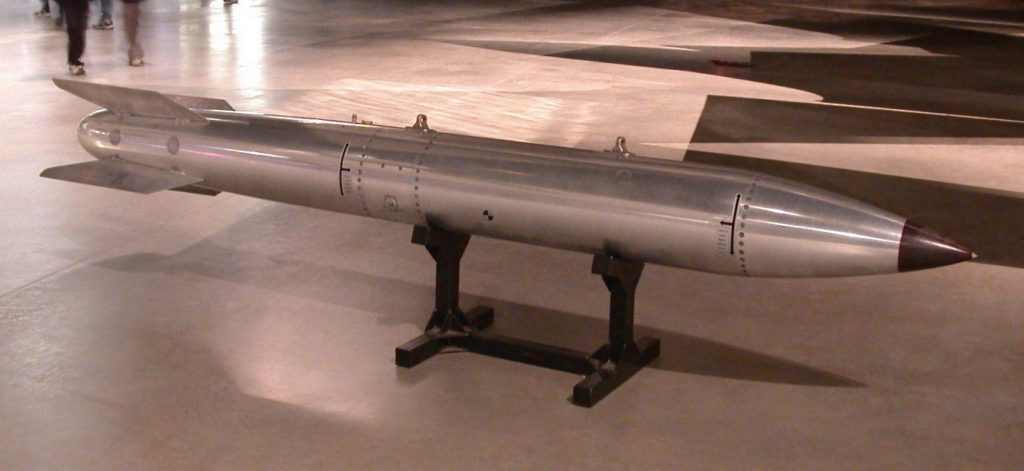
Previous articles explained the U.S. Navy had three different nuclear weapons deployed at sea in 1990. That of course got me curious about the capabilities of those weapons.
One of the articles I cited had an intriguing table listing all of the nuclear weapons carried by the Navy over the last several decades. The table provided the data source in a citation, which led me to the following book: U.S. Nuclear Arsenal / A history of weapons and delivery system since 1945, by Norman Polmar and Robert S. Norris. I splurged and got a copy at a very nice price (better than what is available as of today).
It is an astounding resource. A veritable encyclopedia of the US nuclear arsenal. It covers warheads, reentry vehicles, missiles, helicopters, tactical fighters, and strategic bombers. Astounding.
For the moment I will dive into some information on the weapons deployed with U.S. Navy in 1990, which also probably covers their loadouts for a decade or two earlier. Will have lots more to discuss from the book later.
B43
There were about 1,000 B43 bombs produced. They were in the inventory from 1961 through 1999.
The book says they came in five different yields but the only specific yields listed were 70kt, 500kt, and 1mt.
It came in at about 2,100 pounds with size of 12.5’ x 1.5’.
It was replaced by the B83 for strategic applications and the B61-3 and B61-4 for tactical use.
The aircraft it was carried on give you a feel for it being an older weapon.
The Navy carried it on the A-4, A-6, and A-7. Air Force tactical fighters were F-100, F-101, F-104, F-105, and F-4. Bombers included B-47, B-58, B-52, and FB-111.
The British also borrowed some of these bombs to carry on their aircraft.
B57
This was used for anti-submarine warfare. There were about 3,100 produced. It was in the inventory from 1963 through 1992. It was replaced by the B61 bomb, which is discussed next.
There are four options for yield, ranging from 5kt to 20kt.
It could be loaded into a Mk 44 or M46 torpedo, or a B57 depth charge.
It weighed about 490 pounds and was about 9.8’ x 1.2’.
The Navy could carry it on an A-4, A-6, A-7, or F/A-18. Air Force tactical fighters F-100, F-105, F-4, or F-16 could carry it.
The B-52 and FB-111 could also carry it. I’m not sure why you would put depth charges on a B-52, but that was an option.
Navy patrol craft like the P-2 and P-3 could load some on board.
Some were loaned to three of our allies.
B61
The B61 comes in 12 different modifications. The wide-ranging yield made it both a tactical and strategic weapon.
Book says there were about 3,000 produced. It was placed in inventory back in 1968 and is still in our inventory.
The yields vary from sub- kiloton up to 360kt. Like I said, tactical and strategic.
For tactical use, the B61-3 has yields of 0.3kt, 1.5kt, 60kt, and 170kt and the B61-4 has yields of 0.3kt, 1.5kt, 10kt, and 45kt.
In the strategic realm, the B61-7 and B61-11 both have variable yields up to 360kt.
It weighs in at about 715 pounds in a size of around 11.9’ x 1.1’.
The wide range of weapon systems which carry it illustrate the huge versatility of this bomb:
- Navy: A-4, A-6, A-7, F/A-18
- Air Force fighters: F-100, F-104, F-105, F-15, F-16, F-117
- Air Force bombers: B-1B, B-2A, B-52G/H, FB-111
- missiles: ALCM, SLCM, Pershing II
It has also been made available for seven of our allies to use.
Megaton Equivalent
How do the above weapons and the various production models compare to each other in terms of power? The relationship is not geometric. In other words, a 60kt nuclear weapon is not ten times more powerful than a 6kt weapon.
The relationship is expressed by converting to megaton equivalent (MTE). This is done with the formula of yield in megatons raised to the two-thirds power.
Algebraic term is thus:
- MTE = mt^(2/3)
The comparative yields of a few variations mentioned above:
| kt | mt | MTE |
| 0.3 | 0.0003 | 0.004 |
| 1.5 | 0.0015 | 0.013 |
| 60.0 | 0.06 | 0.153 |
| 170.0 | 0.17 | 0.307 |
| 370.0 | 0.37 | 0.515 |
So a 1.5kt nuke is only 3 times as powerful as 0.3kt. A 60kt nuke may mathematically be 200 times larger than 0.3kt, but is only 34 times as powerful.
A 370kt strategic nuke is 310kt larger than 60kt, which is 6.2 times bigger arithmetically, yet it is only 3.3 times more powerful.
A recap of key data on above three weapons:
| B43 | B46 | B61 | |
| approx. producton | 1,000 | 3,100 | 3,000 |
| enter inventory | 1961 | 1963 | 1968 |
| leave inventory | 1999 | 1992 | curent |
| yield, low end | 70kt | 5kt | 0.3kt |
| yield, high end | 1mt | 20kt | 360kt |